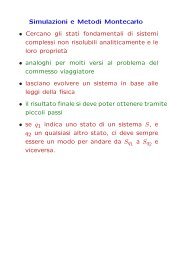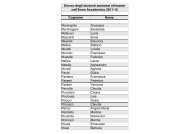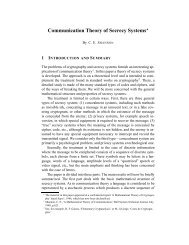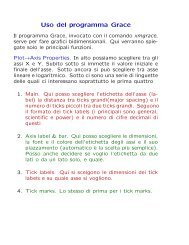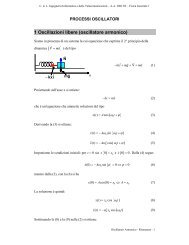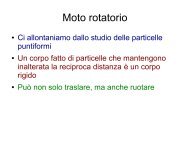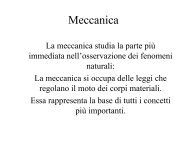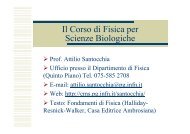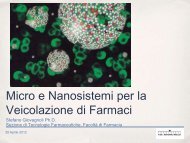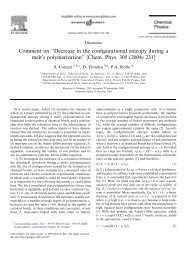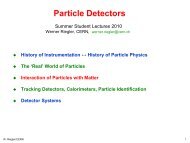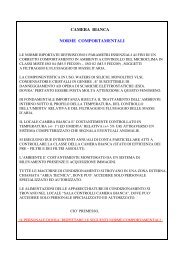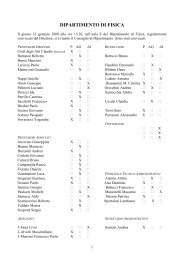Two crossover regions in the dynamics of glass forming ... - Fisica
Two crossover regions in the dynamics of glass forming ... - Fisica
Two crossover regions in the dynamics of glass forming ... - Fisica
You also want an ePaper? Increase the reach of your titles
YUMPU automatically turns print PDFs into web optimized ePapers that Google loves.
J. Chem. Phys., Vol. 117, No. 5, 1 August 2002 <strong>Two</strong> <strong>crossover</strong> <strong>regions</strong> <strong>in</strong> <strong>the</strong> <strong>dynamics</strong> <strong>of</strong> epoxy res<strong>in</strong>s<br />
TABLE IV. Comparison <strong>of</strong> -<strong>crossover</strong> and -<strong>crossover</strong> properties for<br />
PPGE.<br />
Property a <strong>crossover</strong> <strong>crossover</strong><br />
Onset (→0) <strong>of</strong> <strong>the</strong> lowtemperature<br />
process ii<br />
Yes No<br />
Frequency gap Yes No<br />
Scenario I II<br />
Stickel bend iii No Yes<br />
Decoupl<strong>in</strong>g <strong>of</strong> and iv ? Yes<br />
Adam–Gibbs bend v ? Yes Ref. 60<br />
a<br />
The roman numerals <strong>in</strong> paren<strong>the</strong>ses are related to <strong>the</strong> properties ii–v <strong>of</strong><br />
<strong>the</strong> Introduction.<br />
and electric conductivity <strong>in</strong> <strong>the</strong> -<strong>crossover</strong> region property<br />
iv, Fig. 8. Calorimetric data published elsewhere 60 <strong>in</strong>dicate<br />
a weak Adam–Gibbs bend <strong>in</strong> <strong>the</strong> same region property v;<br />
<strong>in</strong> Table II, T AG is <strong>the</strong> temperature above which <strong>the</strong> deviation<br />
from <strong>the</strong> Adam–Gibbs relation, log (S cT) 1 , becomes appreciable.<br />
The discussion <strong>of</strong> Secs. IV A and IV B is summarized<br />
<strong>in</strong> Table IV.<br />
C. process below <strong>the</strong> <strong>crossover</strong><br />
For <strong>the</strong> discussion <strong>of</strong> <strong>the</strong> process below <strong>the</strong> <strong>crossover</strong><br />
we use <strong>the</strong> experimental cooperativity N (T) obta<strong>in</strong>ed<br />
from <strong>the</strong> 3-method calorimetry Fig. 10. A fair representation<br />
<strong>of</strong> its temperature dependence is usually 28,34,61<br />
1/2<br />
N A1x/x, 4<br />
with x a reduced temperature between Vogel temperature<br />
(x0) and a formal cooperativity-onset temperature (x<br />
1/2<br />
→1,N →0),<br />
c<br />
xTT 0/T onT0,<br />
5<br />
where A is a constant typically between 2 and 15, 61 T0 <strong>the</strong><br />
c<br />
Vogel temperature, and Ton <strong>the</strong> cooperativity-onset temperature.<br />
For PPGE, Fig. 10 conta<strong>in</strong>s N data for temperatures<br />
between T264 K and 283 K, and <strong>the</strong> -<strong>crossover</strong> region is<br />
located around T298 K. In extrapolat<strong>in</strong>g Eq. 4 to f<strong>in</strong>d <strong>the</strong><br />
cooperativity-onset temperature we take <strong>the</strong> Vogel temperature<br />
T0 from <strong>the</strong> VFT parameters for <strong>the</strong> low- temperature<br />
part <strong>of</strong> <strong>the</strong> trace Table II, T0214 K. Us<strong>in</strong>g Eq. 4, we<br />
c<br />
obta<strong>in</strong> <strong>the</strong> best fit <strong>of</strong> <strong>the</strong> data <strong>of</strong> Fig. 10 for A5.3 and Ton 327 K. This gives a more realistic onset temperature cor-<br />
(1)<br />
respond<strong>in</strong>g to N1, T(N 1)T on 309 K Fig. 10.<br />
Consider<strong>in</strong>g <strong>the</strong> large uncerta<strong>in</strong>ty affect<strong>in</strong>g N(30%), a<br />
good fit <strong>of</strong> <strong>the</strong> data is still obta<strong>in</strong>ed with A7.5, which gives<br />
(1)<br />
Ton 299 K. This value is not far from that which can be<br />
obta<strong>in</strong>ed from a l<strong>in</strong>ear extrapolation <strong>of</strong> <strong>the</strong> same data, giv<strong>in</strong>g<br />
(1)<br />
Ton 296 K. These temperature values <strong>in</strong>dicate that <strong>the</strong><br />
(1)<br />
cooperativity-onset temperature Ton for PPGE as def<strong>in</strong>ed by<br />
N→1 is <strong>in</strong>side, or slightly above, <strong>the</strong> -<strong>crossover</strong> region. 62<br />
D. Of which type is <strong>the</strong> ma<strong>in</strong> process between and<br />
<strong>crossover</strong>s, a or ?<br />
We come now to <strong>the</strong> question B asked at <strong>the</strong> end <strong>of</strong> <strong>the</strong><br />
Introduction: What is <strong>the</strong> character <strong>of</strong> that part <strong>of</strong> <strong>the</strong> ma<strong>in</strong><br />
transition between <strong>the</strong> two <strong>crossover</strong> <strong>regions</strong>? In general, for<br />
2445<br />
liquids <strong>of</strong> moderate molecular and structural complexity<br />
characterized by a s<strong>in</strong>gle <strong>crossover</strong> region, 24,28 <strong>the</strong> ma<strong>in</strong> transition<br />
can be characterized as follows.<br />
Above <strong>the</strong> <strong>crossover</strong> region we have <strong>the</strong> a process with<br />
<strong>the</strong> higher Vogel temperature when fitted by a VFT equation.<br />
In <strong>the</strong> molecular picture discussed <strong>in</strong> Ref. 24, <strong>the</strong> correspond<strong>in</strong>g<br />
diffusion can be described as escap<strong>in</strong>g <strong>of</strong> <strong>the</strong> particle<br />
from a cage 40 formed by <strong>the</strong> nearest neighbors. The<br />
cooperativity is <strong>of</strong> order N 1 when determ<strong>in</strong>ed by Eq. 3<br />
and decreases with higher temperatures. Such small cooperativities<br />
are unexpected and may be expla<strong>in</strong>ed by an extraord<strong>in</strong>ary<br />
concentration <strong>of</strong> free volume as generated by <strong>the</strong><br />
Lévy distribution describ<strong>in</strong>g <strong>the</strong> escap<strong>in</strong>g process. We may<br />
th<strong>in</strong>k about a ‘‘cage door’’ <strong>of</strong> size <strong>of</strong> about one particle temporarily<br />
opened by this concentration <strong>of</strong> free volume. 24<br />
Below <strong>the</strong> <strong>crossover</strong> region we have <strong>the</strong> process with<br />
<strong>the</strong> lower Vogel temperature. The spatial aspect <strong>of</strong> its dynamic<br />
heterogeneity may be described 24 by an island <strong>of</strong> high<br />
mobility 63 assisted by a cooperativity shell <strong>of</strong> low mobility.<br />
The particle diffusion may be considered as generated by a<br />
diffusion <strong>of</strong> this island Glarum defect diffusion 64 . This island<br />
<strong>of</strong> mobility may also be expla<strong>in</strong>ed by an extraord<strong>in</strong>ary<br />
concentration <strong>of</strong> free volume from a Lévy distribution. The<br />
spatial scale, however, is larger than that for <strong>the</strong> hightemperature<br />
a process and may generate sufficient free space<br />
for a secondary process at <strong>the</strong> island. In this molecular picture,<br />
<strong>the</strong> CRR as a representative subsystem for <strong>the</strong> ma<strong>in</strong><br />
transition consists <strong>of</strong> two parts: <strong>the</strong> island <strong>of</strong> mobility and <strong>the</strong><br />
cooperativity shell; <strong>the</strong> mobility contrast between <strong>the</strong>se parts<br />
is responsible for <strong>the</strong> dynamic heterogeneity <strong>of</strong> <strong>the</strong> process.<br />
The cooperativity is <strong>the</strong>n <strong>the</strong> number <strong>of</strong> particles per<br />
CRR; it <strong>in</strong>creases sharply with low temperatures and reaches<br />
values <strong>of</strong> order N 100 some 50 K below <strong>the</strong> <strong>crossover</strong><br />
region.<br />
S<strong>in</strong>ce we have two <strong>crossover</strong> <strong>regions</strong> <strong>in</strong> PPGE, <strong>the</strong> question<br />
arises whe<strong>the</strong>r <strong>the</strong> ma<strong>in</strong> process between <strong>the</strong> two <strong>crossover</strong>s<br />
is more an a process <strong>in</strong> which case it will be called <strong>the</strong><br />
a process, because it is above <strong>the</strong> <strong>crossover</strong>, or it is more<br />
an process <strong>in</strong> which case it will be called <strong>the</strong> process,<br />
because it is below <strong>the</strong> <strong>crossover</strong>. Reflect<strong>in</strong>g <strong>the</strong> discussion<br />
<strong>in</strong> <strong>the</strong> previous subsections, Table IV, and <strong>the</strong> above criteria,<br />
we obta<strong>in</strong> <strong>the</strong> follow<strong>in</strong>g <strong>in</strong>dications.<br />
In favor <strong>of</strong> an a process, we have <strong>the</strong> small cooperativity<br />
N 1 obta<strong>in</strong>ed from <strong>the</strong> extrapolation at temperatures<br />
higher than <strong>the</strong> <strong>crossover</strong>. This result is deduced upon <strong>the</strong><br />
condition that <strong>the</strong>re is no N <strong>in</strong>crease with <strong>in</strong>creas<strong>in</strong>g temperature<br />
as observed for 19 systems studied so far by heat<br />
capacity spectroscopy 28 apart from <strong>the</strong> <strong>in</strong>dication <strong>of</strong> a weak<br />
N (T) irregularity <strong>in</strong> <strong>the</strong> -<strong>crossover</strong> region <strong>of</strong> ortho-cresyl<br />
glycidyl e<strong>the</strong>r 65 . O<strong>the</strong>r arguments for an a process are <strong>the</strong><br />
location above a Stickel bend, above <strong>the</strong> start <strong>of</strong> a - decoupl<strong>in</strong>g,<br />
and above a bend <strong>in</strong> <strong>the</strong> Adam–Gibbs plot.<br />
In favor <strong>of</strong> an process, we have <strong>the</strong> occurrence at<br />
higher temperature <strong>of</strong> a dielectric onset with frequency gap,<br />
i.e., <strong>the</strong> location below a <strong>crossover</strong> region <strong>of</strong> <strong>the</strong> type described<br />
as scenario I.<br />
Summariz<strong>in</strong>g this subsection, we f<strong>in</strong>d more arguments<br />
suggest<strong>in</strong>g that <strong>the</strong> ma<strong>in</strong> process between <strong>the</strong> and <strong>crossover</strong>s<br />
is an a process hence, a process. Accord<strong>in</strong>gly, we<br />
Downloaded 14 Nov 2002 to 194.95.63.241. Redistribution subject to AIP license or copyright, see http://ojps.aip.org/jcpo/jcpcr.jsp



